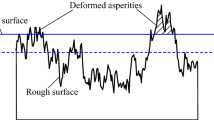Abstract
Because the result of the MB fractal model contradicts with the classical contact mechanics, a revised elastoplastic contact model of a single asperity is developed based on fractal theory. The critical areas of a single asperity are scale dependent, with an increase in the contact load and contact area, a transition from elastic, elastoplastic to full plastic deformation takes place in this order. In considering the size distribution function, analytic expression between the total contact load and the real contact area on the contact surface is obtained. The elastic, elastoplastic and full plastic contact load are obtained by the critical elastic contact area of the biggest asperity and maximun contact area of a single asperity. The results show that a rough surface is firstly in elastic deformation. As the load increases, elastoplastic or full plastic deformation takes place. For constant characteristic length scale G, the slope of load-area relation is proportional to fractal dimension D. For constant fractal dimension D, the slope of load-area relation is inversely proportional to G. For constant D and G, the slope of load-area relation is inversely proportional to property of the material ϕ, namely with the same load, the material of rough surface is softer, and the total contact area is larger. The contact mechanics model provides a foundation for study of the friction, wear and seal performance of rough surfaces.
Similar content being viewed by others
References
GREENWOOD J A, WILLIAMSON J B P. Contact of nominally flat surfaces[C]//Proceedings of the Royal Society of London A: Mathematical, Physical and Engineering Sciences, London, English, December, 1966, 295(1442): 300–319.
CHANG W R, ETSION I, BOGY D B. An elastic-plastic model for the contact of rough surfaces[J]. Journal of Tribology, 1987, 109(2): 257–263.
CIAVARELLA M, DELFINE V, DEMELIO G. A “re-vitalized” Greenwood and Williamson model of elastic contact between fractal surfaces[J]. Journal of the Mechanics and Physics of Solids, 2006, 54(12): 2569–2591.
MAJUMDAR A, BHUSHAN B. Fractal model of elastic-plastic contact between rough surfaces[J]. Journal of Tribology, 1991, 113(1): 1–11.
MAJUMDAR A, BHUSHAN B. Role of fractal geometry in roughness characterization and contact mechanics of surfaces[J]. Journal of Tribology, 1990, 112(2): 205–216.
PENG Y F, GUO Y B. An elastic-plastic adhesion model for contacting fractal rough surface and perfectly wetted plane with meniscus[J]. Chinese Journal of Mechanical Engineering, 2009, 22(1): 9–14.
MORAG Y, ETSION I. Resolving the contradiction of asperities plastic to elastic mode transition in current contact models of fractal rough surfaces[J]. Wear, 2007, 262(5): 624–629.
KOGUT L, ETSION I. Elastic-plastic contact analysis of a sphere and a rigid flat[J]. Journal of Applied Mechanics, 2002, 69(5): 657–662.
LIOU J L, LIN J F. A new microcontact model developed for variable fractal dimension, topothesy, density of asperity, and probability density function of asperity heights[J]. Journal of Applied Mechanics, 2007, 74(4): 603–613.
LIOU J L, TSAI C M, LIN J F. A microcontact model developed for sphere- and cylinder-based fractal bodies in contact with a rigid flat surface[J]. Wear, 2010, 268(3): 431–442.
LIOU J L, LIN J F. A modified fractal microcontact model developed for asperity heights with variable morphology parameters[J]. Wear, 2010, 268(1): 133–144.
MIAO X M, HUANG X D. A complete contact model of a fractal rough surface[J]. Wear, 2014, 309(1): 146–151.
CHEN Hui, HU Yuanzhong, WANG Hui, et al. Simulation and characterization of fractal rough surfaces[J]. Chinese Journal of Mechanical Engineering, 2006, 42(9): 219–223. (in Chinese)
SAYLES R S, THOMAS T R. Surface topography as a nonstationary random process[J]. Nature, 1978, 271(2): 431–434.
YANG Hongping, FU Weiping, WANG Wen, et al. Calculation model of the normal contact stiffness of joints based on the fractal geometry and contact theory[J]. Chinese Journal of Mechanical Engineering, 2013, 49(1): 102–107. (in Chinese)
JOHNSON K L. Contact mechanics[M] Cambridge: Cambridge University Press, 1987.
WANG S, KOMVOPOULOS K. A fractal theory of the interfacial temperature distribution in the slow sliding regime: Part II–Multiple domains, elastoplastic contacts and applications[J]. Journal of Tribology, 1994, 116(4): 824–832.
HAN J H, SHAN P, HU S S. Contact analysis of fractal surfaces in earlier stage of resistance spot welding[J]. Materials Science and Engineering, 2006, 435(A): 204–211.
JI CUICUI, ZHU HUA, JIANG Wei. Fractal prediction model of thermal contact conductance of rough surfaces[J]. Chinese Journal of Mechanical Engineering, 2013, 26(1):128–136.
BHUSHAN B. The real area of contact in polymeric magnetic media: Experimental data and analysis[J]. ASLE Transactions, 1985, 28(2): 181–197.
WEI Long, LIU Heqi, ZHANG Penggao. Sliding friction surface contact mechanics model based on fractal theory[J]. Chinese Journal of Mechanical Engineering, 2012, 48(17): 106–113. (in Chinese).
Author information
Authors and Affiliations
Corresponding author
Additional information
Supported by National Natural Science Foundation of China(Grant Nos. 51105304, 51475364), and Shaanxi Provincial Natural Science Basic Research Plan of China(Grant No. 2015JM5212)
GAN Li, born in 1990, is currently a master candidate at Xi’an University of Technology, China. His research interests include rough surface mechanical properties.
LIU Kai, born in 1957, is currently a professor and a PhD candidate supervisor at Xi’an University of Technology, China. His research interests include mechanical transmission theory and application.
YANG Xiaohui, born in 1979, is currently a PhD candidate and a senior engineer at Xi’an Jiaotong University, China. His main research interests include the structure stability analysis and the fatigue life prediction.
Rights and permissions
About this article
Cite this article
Yuan, Y., Gan, L., Liu, K. et al. Elastoplastic contact mechanics model of rough surface based on fractal theory. Chin. J. Mech. Eng. 30, 207–215 (2017). https://doi.org/10.3901/CJME.2016.0624.079
Received:
Revised:
Accepted:
Published:
Issue Date:
DOI: https://doi.org/10.3901/CJME.2016.0624.079




